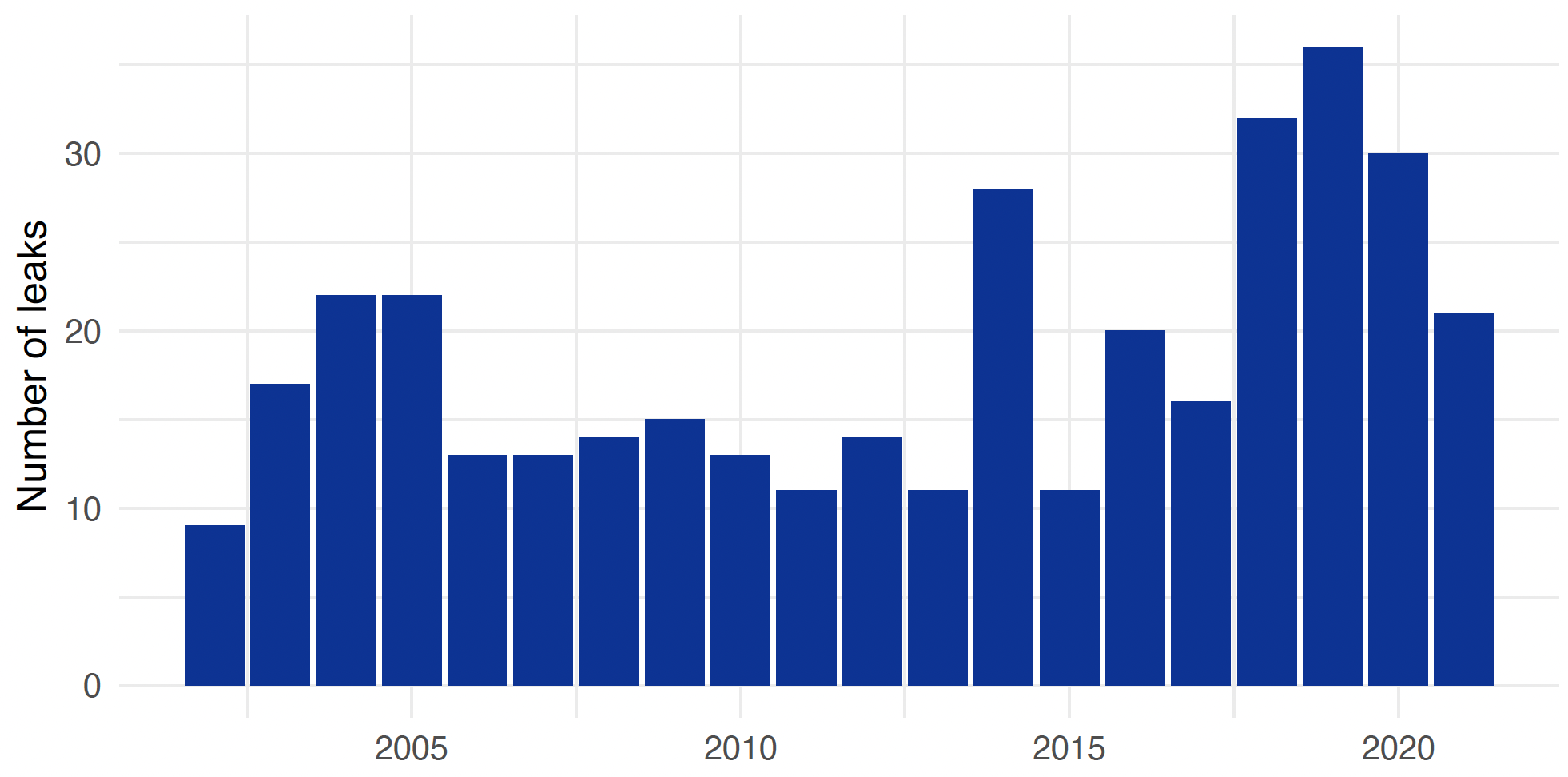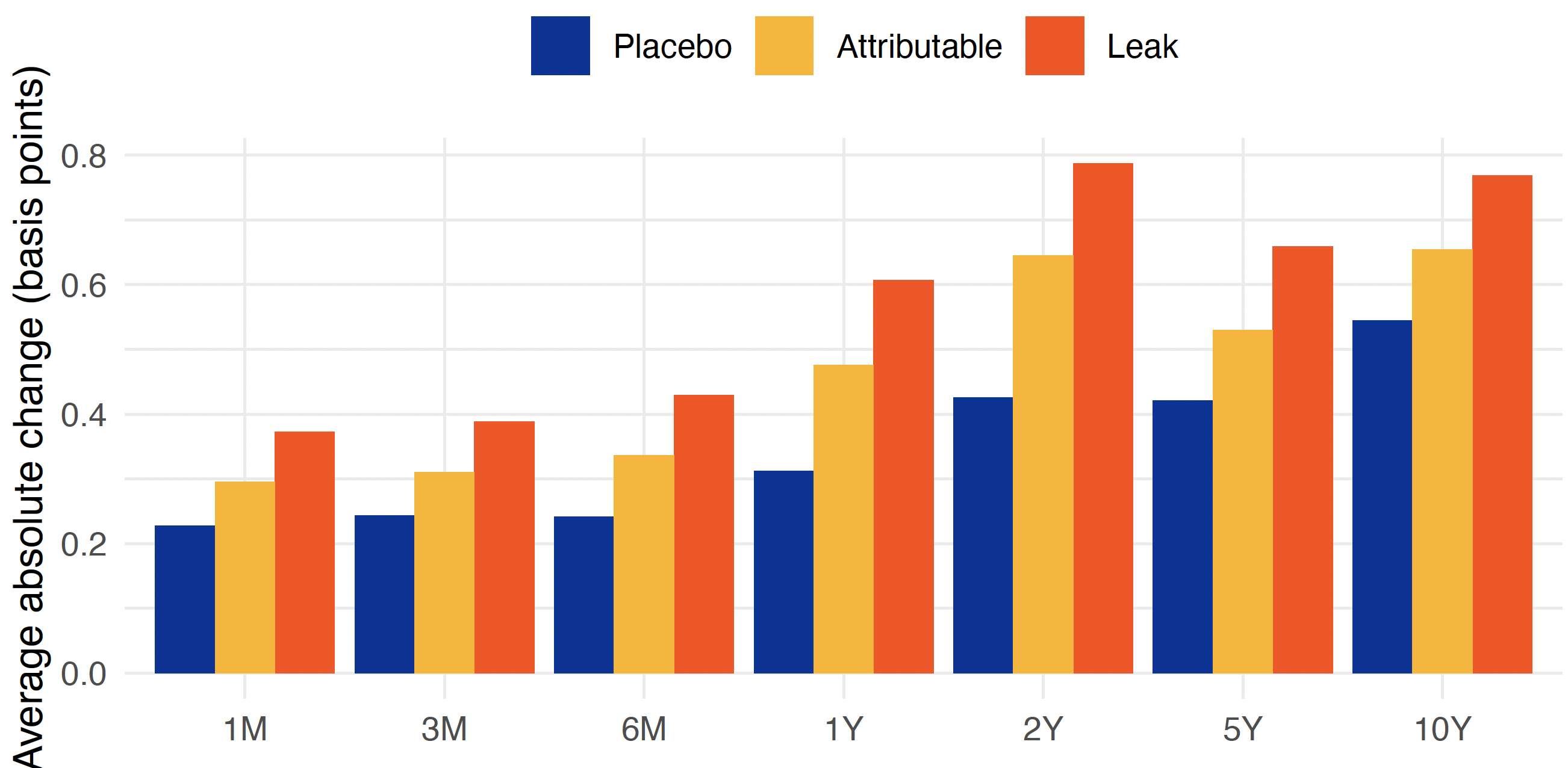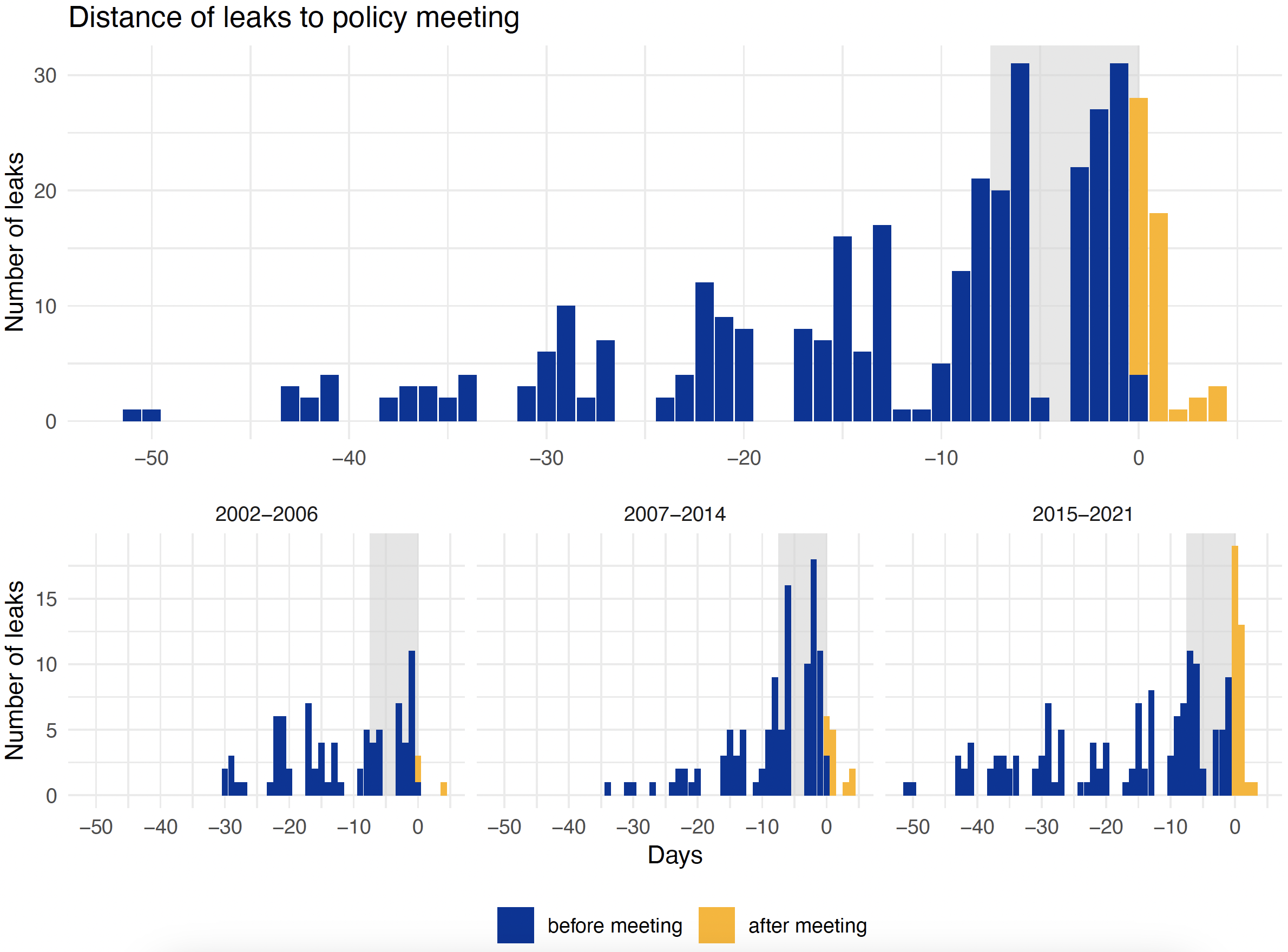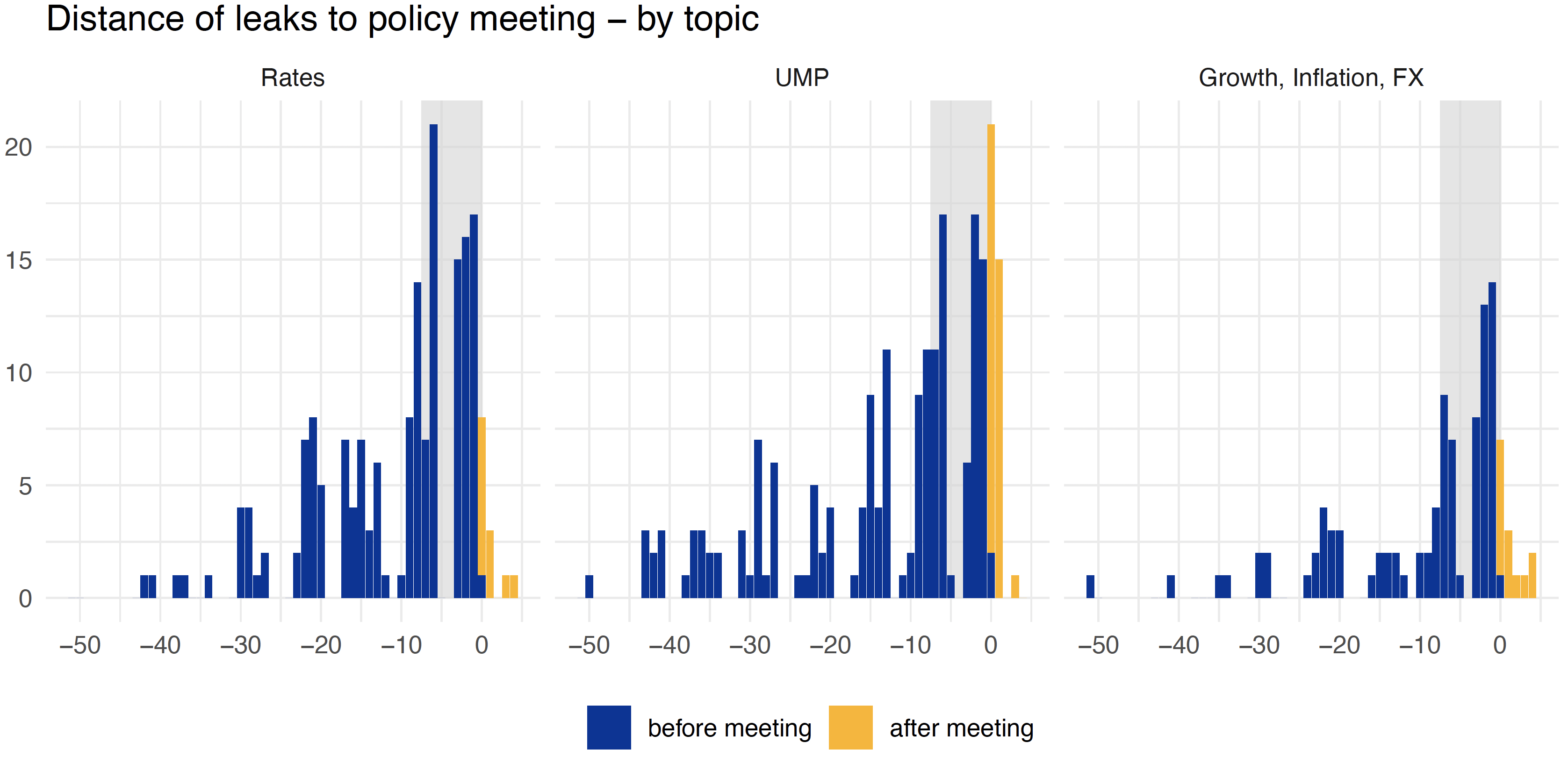According to practitioners and scientific experts, public institutions around the world “leak like sieves” (Grønbach Jensen 1998, Pozen 2013, Rottman 2019). Disclosures of confidential information that are transmitted by insiders to the media with an expectation of anonymity have even been characterised as a “routine method of communication about government” (House Committee on the Judiciary 1982, Lee 2008, Herrmann 2015).
Leaks can have a large impact on public policymaking. For instance, they may harm the credibility and reputation of public institutions, in particular, if they trigger unintended side effects or turn out to be factually wrong (Oei and Ring 2018, Assenmacher et al. 2021). In addition, leaks could reduce policy flexibility (Fehrler and Hahn 2023) and cause considerable welfare losses whenever they lock in decision makers on undesirable paths by moving public opinion in specific directions (Vissing-Jorgensen 2019).
Despite the long-standing interest in leaks and their potential implications, in the academic literature, “our comprehension of leaking has not kept pace with our fascination” (Pozen 2013). For example, we still know little about how leaks affect public views and attempts to quantify the precise impact of leaks on the effectiveness of public policy have remained elusive. We also lack systematic evidence indicating whether official communication can act as a tool to mitigate the potentially adverse impact of leaks on public opinion and institutional credibility. Another fundamental, yet difficult to answer question concerns the nature of leaks. While public policy leaks may simply be random accidents, they could also represent intentional releases by individuals with their own agendas or constitute institutionally authorised ‘plants’.
Central banks constitute promising cases to study public policy leaks
One important reason for these gaps in the literature is the mismatch between the high-frequency nature of news about leaks and the lack of fast-moving variables that could capture public perceptions and public policy outcomes. In a recent paper (Ehrmann et al. 2023), we attempt to overcome this challenge by analysing leaks from one specific area of public policymaking: central banking. Central banks constitute particularly promising cases to study public policy leaks because news about monetary policy instantaneously moves financial markets. Since markets listen when central banks speak, we can obtain a reliable high-frequency measure to study the impact of leaks on public views and policy effectiveness: financial market tick data. To be sure, there are also other advantages of studying central bank leaks. On the one hand, the well-defined scope and the recurrent nature of monetary policy decisions ensure that the content of related leaks is comparable over time, allowing the compilation of a consistent database over a long sample period. On the other hand, monetary policy represents a clear-cut case of decision-making by the committee. Therefore, our analysis speaks to a form of decision-making prevalent in many public institutions, especially at the supranational level (e.g. the Council of the European Union, the United Nations Security Council or the World Trade Organization’s General Council).
What 368 leaks from the Eurosystem can tell us about the impact and nature of public policy leaks
In our study, we focus on the case of the Eurosystem, i.e. the national central banks (NCBs) of the euro area countries and the ECB. We compile a novel database of 368 leaks related to monetary policy, including their precise time stamps to the minute, by filtering the Reuters, Bloomberg and Market News International archives between 2002 and 2021. Figure 1 shows that the number of annual Eurosystem leaks peaked in 2019, with an average of more than four leaks per policy meeting.
Figure 1 Number of leaks per year
Notes: This figure plots the annual counts of all Eurosystem leaks related to monetary policy topics, i.e. “policy rates”, “unconventional monetary policy (UMP)”, “economic growth”, “inflation” and “euro exchange rate” for the period 2002 to 2021.
Source: Ehrmann et al. (2023)
Our study delivers three sets of results. First, to quantify the market impact of leaks, we look at high-frequency movements in overnight indexed swaps (OIS) over 35-minute event windows around the occurrence of leaks. We find that leaks trigger market movements that are around 60-95% larger than normal, and around 15-30% larger than the average effect of public statements by Governing Council members (see Figure 2). While our results show that leaks counteract prevailing trends in market expectations and weaken the effect of official policy announcements on longer-term expectations, the average pre-meeting leak does not move public expectations closer to the eventual policy outcome. This suggests that leaks largely originate from insiders with minority opinions, but also that the Governing Council is not locked in by anonymous disclosures. Hence, leaks appear to mainly add noise to official central bank communication, such that market participants would seem to be better off if they treated most leaks about Eurosystem monetary policy with caution.
Figure 2 Market reaction to events (basis points)
Notes: The figure plots the average absolute change in basis points in overnight indexed swap (OIS) rates over an event window from five minutes before attributed statements (yellow bars) or leaks (red bars) to 30 minutes afterwards, compared to the average absolute change in OIS rates during a 35-minute time window around 5,000 placebo events (i.e. normal movements) that match the distribution of leaks over time (blue bars). For each maturity and comparison, the differences in the effects are statistically significant at the 1% level.
Source: own calculations based on Ehrmann et al. (2023)
Our second set of results suggests that many Eurosystem leaks are no accidents. We find that the incidence of leaks exhibits clear patterns over time. Anonymous disclosures generally cluster around monetary policy meetings, partially at a time when policymakers’ media contacts are restricted by the ECB’s quiet period rules (see Figure 3). We also observe a notable shift in the timing of leaks from before the monetary policy meetings to after the meetings since 2015, a development driven by leaks related to unconventional monetary policy (UMP) (see Figure 4). Our study corroborates this descriptive evidence by uncovering several empirical regularities using regression analysis. We document a systematic relationship between leaks, proxies for disagreement among policy-makers and specific events linked to the conduct of monetary policy.
Figure 3 Distance of leaks to policy meeting
Notes: This figure plots the distribution of all leaks related to the topics “policy rates”, “UMP”, “economic growth”, “inflation” and “euro exchange rate” around policy meetings. On the policy announcement day, a leak is classified as ‘before meeting’ if it occurs before the ECB’s press release (13:45 CET) and as ‘after meeting’ otherwise. The horizontal axis measures the distance to the closest policy meeting in calendar days. The upper panel summarises our whole sample period (January 2002 – December 2021), whereas the lower panel distinguishes three sub-periods – the pre-crisis period (2002-2006), the acute crisis phase (2007-2014) and the subsequent years of extensive use of UMP (2015-2021). The area shaded in grey indicates the ECB’s quiet period.
Source: Ehrmann et al. (2023)
Figure 4 Distance of leaks to policy meeting, by topic
Notes: This figure plots the distribution of leaks around policy meetings for three types of leaks – leaks related to policy rates, unconventional policy tools (UMP) and economic conditions. The latter category comprises leaks about economic growth, inflation and the euro exchange rate. The vertical axis measures the distance to the policy meeting in calendar days. On the policy announcement day, a leak is classified as ‘before meeting’ if it occurs before the ECB’s press release (13:45 CET) and as ‘after meeting’ otherwise. The area shaded in grey indicates the ECB’s monetary policy quiet period.
Source: Ehrmann et al. (2023)
Our third series of findings reveal that most Euroystem leaks are unlikely to represent institutional plants. We find that attributable statements by ECB policymakers systematically counteract the market impact of leaks. This result has two implications. First, many Eurosystem leaks seem to be released by individuals pursuing their own agendas instead of being intentionally placed by the institution. Second, attributed communication appears to be effective in mitigating the impact of leaks. Related to this second point, we also show that a higher intensity of attributable communication before leaks correlates with lower market impacts of these anonymous disclosures.
Discussion and outlook
To the best of our knowledge, our unique data and setting make the study underlying this column the most systematic quantitative assessment of public policy leaks to date. Our study contributes to several strands of literature, including interdisciplinary scholarship studying anonymous disclosures of confidential information in the realm of public policymaking; papers on the economics of decision making by, and disagreement in, (monetary policy) committees (McMahon et al. 2015, Tietz et al. 2021); and past work on the effects of ad hoc central bank communication.
We would like to highlight two particular implications of our paper. First, our findings imply that markets respond to leaks although they are generally not informative. The market reaction to leaks can be rationalised by models formalising the impact of media reporting on economic outcomes. Chahrour et al. (2021) show that accurate reporting about unrepresentative developments may still affect agents’ behaviour. The analogy to leaks that mainly represent minority views is straightforward. Also, according to Nimark (2014), “unusual events are more likely to be considered newsworthy than events that are commonplace”, and the mere availability of these signals is in itself informative and affects agents’ beliefs. Leaks are a good example of “man-bites-dog” news: both their form and their information content are highly unusual because most central bank communication goes through official channels and contains little information about disagreement on the Governing Council.
Second, we find that Eurosystem leaks on monetary policy often are released shortly before or after official monetary policy announcements. Hence, pre-policy announcement leaks could affect market expectations prior to the start of event study windows, thereby altering the surprise component of official announcements (Karadi and Jarocinski 2018, Schrimpf and Cieslak 2018). Likewise, post-meeting leaks dampen policy announcement effects. In both cases, monetary policy shocks extracted from official announcements alone may miss the overall extent of new information available to financial market participants. At the same time, accounting for leaks when identifying monetary policy shocks may also increase the relevance of available high-frequency surprise instruments (Ramey 2016, Bauer and Swanson 2022, Swanson 2023).
Several questions remain for future research. In particular, this column has focused on the short-term impact of public policy leaks, leaving aside their potential longer-term implications, for example for the reputation of the institutions concerned.
Authors’ note: The views expressed in this column present the authors’ personal opinions and do not necessarily reflect the views of the ECB, the Oesterreichische Nationalbank or the Eurosystem. This column is also published as a SUERF Policy Brief.
References
Assenmacher, K, G Glöckler, S Holton et al. (2021), “Clear, consistent and engaging: ECB monetary policy communication in a changing world”, ECB Occasional Paper 2021(274).
Bauer, M D and E T Swanson (2022), “A reassessment of monetary policy surprises and high-frequency identification”, NBER Macroeconomic Annual 2022 (37), 1–66.
Chahrour, R, K P Nimark, and S Pitschner (2021), “Sectoral media focus and aggregate fluctuations”, American Economic Review 111(12): 3872–3922.
Ehrmann, M, P Gnan, and K Rieder (2023), “Central Bank Communication by ??? The Economics of Public Policy Leaks”, CEPR Discussion Papers 18152.
Fehrler, S and V Hahn (2023), “Committee decision-making under the threat of leaks”, Journal of Politics 85(3).
Grønbach Jensen, C (1998), “The Scandinavian tradition of open government and the European Union: Problems of compatibility?”, Journal of European Public Policy 5(1): 185–1999.
Herrmann, C (2015), “Transleakancy”, In C Herrmann, B Simma, and R Streinz (Eds.), Trade Policy between Law, Diplomacy and Scholarship, European Yearbook of International Economic Law, Springer.
House Committee on the Judiciary (1982), “Report of the interdepartmental group on unauthorized disclosures of classified information”, Subcommittee on Civil and Constitutional Rights, Hearings on “Presidential directive on the use of polygraphs and prepublication review” (April 21, 28 1983 and February 7, 1984), 166–180.
Karadi, P and M Jarocinski (2018), “The transmission of policy and economic news in the announcements of the US Federal Reserve”, VoxEU.org, 3 October.
Lee, W E (2008), “Deep background: journalists, sources and the perils of leaking”, American University Law Review 57(5): 1453–1529.
McMahon, M, A Prat and S Hansen (2014), “Central bank transparency and committee deliberation”, VoxEU.org, 20 June.
Nimark, K P (2014), “Man-bites-dog business cycles”, American Economic Review 104(8): 2320–2367.
Oei, S-Y and D Ring (2018), “Leak-driven law”, UCLA Law Review 532: 536–618.
Pozen, D E (2013), “The leaky Leviathan: Why government condemns and condones unlawful disclosures of information”, Harvard Law Review 127(2): 512–635.
Ramey, V (2016), “Macroeconomic shocks and their propagation”, In J B Taylor and H Uhlig (eds.), Handbook of Macroeconomics 2(2): 71–162.
Rottman, G (2019), “A typology of federal news media leak cases”, Tulane Law Review 93(5): 1147–1198.
Schrimpf, A and A Cieslak (2018), “Monetary and non-monetary news in central bank communication”, VoxEU.org, 22 October.
Swanson, E T (2023), “The importance of Fed chair speeches as a monetary policy tool”, AEA Papers and Proceedings 113: 394–400.
Tietz, R, B Visser and M Ehrmann (2021), “Voting rights rotation on the US Federal Open Market Committee affects the behaviour of Reserve Bank presidents and matters to financial markets”, VoxEU.org, 29 Jun.
Vissing-Jorgensen, A (2019), “Central banking with many voices: The communications arms race”, Conference Proceedings, 23rd Annual Conference of the Central Bank of Chile 2019: 1–44.










